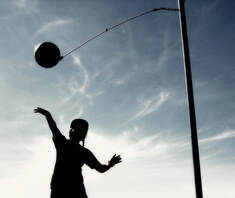 Like most Americans, our family has been hunkered down for the past couple of weeks, avoiding as much social contact as possible to help slow down the spread of COVID-19. It’s meant a lot more “home time” for us, which means more board games, reading, Disney+ and even a little yard work when the weather permits. But even as the weather warms, we expect to spend a lot more time at home this summer than in years past. Events like Holland’s Tulip Time have already been cancelled, and it’s uncertain what other outdoor events and activities will look like in the months ahead. And so we’re already looking forward to some fun activities we can do in our yard.
As we get ready for spring to hit, it’s important to think about your turf, especially if there will be increased traffic on it this year. Chemical fertilizers, while giving an immediate burst of color and growth, don’t actually do much for the overall health of your grass. Plus, chemical fertilizers and weed killers can be harmful for people and pets. Good Sweet Earth offers an alternative that can make your turf better suited for increased foot traffic and playtime, as well as keeping it healthy for kids and pets to roll around on. We use only things found in nature to feed your turf—vermicompost, kelp, alfalfa meal and grains. Sound simple? It is, but we’ve been doing this for more than a decade now, and it really, really works. If you’re interested in getting a quote for services, or learning more, give us a call at 616.594.0693 or email our lawn guy Steve at Steve@GoodSweetEarth.com. More time spent on your lawn means it’s more important than ever to have turf that is both safe for your family AND looks great.
1 Comment
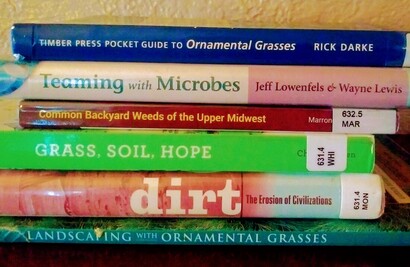 The off-season (November-March) at the Good Sweet Earth homestead is the time of year we like to recharge our batteries and expand our knowledge base. That means a little travel, a little rest, but also a lot of continuing education, research, workshops and reading. Steve (our lawn guy), has decided to focus on two areas of study this year: Learning as much as he can about common lawn weeds found in Michigan, and the physiology of ornamental grasses. That means, in addition to the usual reading about faming, soils, microbes, turf and vermicompost, he’ll be entering the 2020 growing season (hopefully!) with a whole new level of understanding of ornamental grasses and weeds, and how those relate to a healthier, more beautiful yard. So while some of our outside learning comes in the form of classes, much of it comes from good old-fashioned trips to the public library, and browsing the shelves for good books to fill the cold winter months. We thought we’d share with you some of what we’re reading this January, and how it’s informing and inspiring us as we enter a new year.
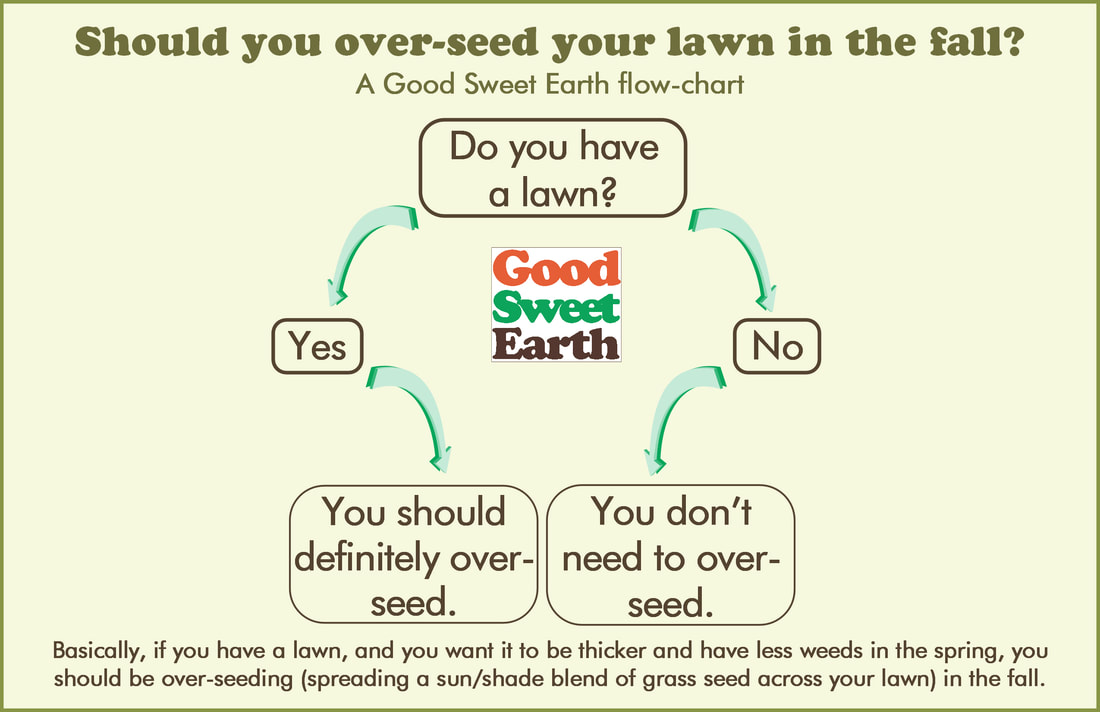 In nature, diversity is king. That’s why it can be so challenging to keep weeds out of your lawn. If there’s even a quarter-sized gap in your turf, chances are some seed will find a home there and germinate. To be honest, the only way you’ll ever have a lawn with zero percent weed coverage is with a lot of chemicals. That’s how golf courses do it, that’s how professional baseball stadiums do it, and that’s how your neighbors with the weed-free lawns do it. When you have a natural yard, you have to accept that nature doesn’t want you to have absolutely no diversity in your lawn. With that being said, you can still work toward having a lawn with less diversity. First, having healthier soil will provide a template for healthier turf. That’s where our organic lawn fertilization and Worm Tea service comes in. Strong, healthy grass won’t grow in sterile, lifeless soil. Next, as you get healthier soil, you need to stay ahead of the weeds. Pull out what you can by hand. But more importantly, fill in the gaps with grass seed after the heat of summer has passed. Late August to mid September is the best time to do this, as it gives the seed time to germinate before winter, and there will be less spots for weed seeds to find a home in the spring. Buy a bag of a sun/shade blend grass seed. Mow your lawn shorter than you normally would, so the seed will have an easier time finding the soil. Shorter grass also means you can go a little longer between mows, which gives the seed a better chance at germination too. Next, broadcast it with a spreader or scatter it by hand. Mixing the seed with top soil and compost before you broadcast it can be helpful. Larger bare spots in your yard could benefit from applying that seed/soil/compost mixture as a “patch.” Finally, if you've got more than 60% weed coverage in your lawn, you may have to come to the conclusion that the weeds have taken over. If you want grass to reclaim your lawn, you'll likely have to re-seed or re-sod. It's just too difficult to bring back healthy turf once the weeds take control, especially if you're going the chemical-free route. 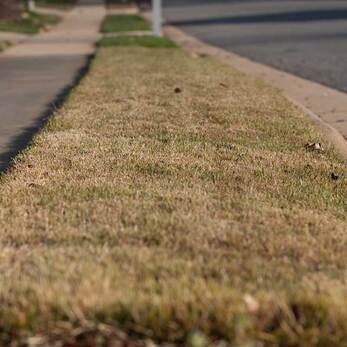 Spring is past, and we’ve now transitioned into the hotter, dryer days of summer. That means fresh tomatoes, berries, peppers, roses...and brown grass. Yep. It’s nature, people. For those of us living in West Michigan (actually, everyone north of Kentucky), we have what’s called “cool weather turf.” That means once the temps regularly hit the 80s, the grass goes to sleep-- just like it does in winter. It’s not dead-- let me reiterate that point: Brown grass isn't necessarily dead grass. It’s just resting and building up energy for the next growing season, which happens to be autumn. Cool weather turf greens up and grows when temps range between 60 and 75. That’s the sweet spot you have in the spring and fall, and that’s why you’re constantly mowing in May, June, late September and early October. So what’s an ecologically-friendly homeowner to do during these crispy summer months? The most-environmentally-friendly answer is: Nothing. Let it sleep. Grass can go about 10-14 days (depending on how high the temps go) without water before it actually dies. Once you get into the third week without any water on your lawn, give it a good, deep watering early in the morning. A good way to tell the difference between dead and dormant grass? Give it a good tug. If it comes out easily, it's dead and it ain't coming back. If it stays put, it's just dormant and doing exactly what God intended in the summer. If you don’t want it to go too dormant (and get too brown) you can give it a good deep watering whenever it gets too brown for your own comfort level. Maybe you want your grass to stay as green as possible. That means you could be watering every third day. Maybe you just want to keep it from going dormant; that might mean you water once a week. Whatever you decide, the key is to water deeply-- 30-60 minutes whenever you turn the sprinklers on. Deeper waterings mean the turf's roots grow deeper into the ground. And that means your grass will be able to find water deeper in the soil. But here’s a little secret: When you treat your lawn organically, your turf won’t get as crispy as a lawn treated with synthetic chemicals during dormancy. Why? The soil is healthier and can tolerate heat and drought better. It can hold on to water better. Plus, those longer waterings mean your turf’s roots have grown deep into the ground and are better able to find water, even when it doesn’t rain. Bottom line. Your grass is supposed to go dormant, and turn brown, twice a year: winter and summer. During those times, it’s building up carbohydrates for the next growing season. However, to keep it from going too dormant, give it a deep watering on occasion, or whenever you want to see a little more green color on your lawn. Avoid short, daily waterings. Regardless of how much you water, it's just natural for your grass to have some brown in it in the summer. So relax, and enjoy the season! It'll be fall before you know it, and your grass will be green again. 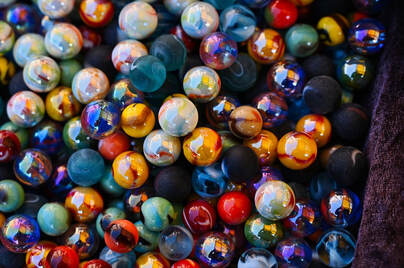 This is a Q&A blog series on healthy organic turf. If you have a question for Good Sweet Earth's lawn guy, Steve, shoot him an email at steve@GoodSweetEarth.com, and include "Ask the Lawn Guy" in the subject line. Most people know what sandy soil and clay soil look like. They know that sandy soil is pretty loose and doesn't hold water very well. They know that clay soil can often feel hard and compacted. Most people also also know that nothing grows especially well in soil that's either of these two things. Somewhere in between sand particles and clay particles lies silt. Loam soil contains a balance of all three types of particles. So the question that I got recently was this: "How much sand should I add to my clay soil to loosen it up and make it usable?" And I suppose the counterpart to this question could be "How much clay should I add to sandy soil?" In short, the answer is: Don't bother. You'll make your soil even worse by trying to change its structure with sand or clay. Imagine your clay particles as marbles. Proportionally speaking, silt would be about the size of a basketball compared to those marbles. Now I had a hard time coming up with a real-world object that would be representative of a sand particle next to our marble-sized clay particle. The best I could come up with is this: Picture a ball slightly larger than a three-car garage. Yep. That's a sand particle next to a clay particle. Now imagine you had a field full of marbles. And you want to "loosen" things up. I don't care how many three-car garages you add to that field of marbles, you're never, ever going to end up with a field full of basketballs. You're just gonna have a bunch of really small balls and really large balls, and they're not going to work together for anyone's good because you're never going to have enough garage-balls to balance the little marbles. Ideally, healthy soil is equal parts marbles, basketballs and three-car garages. But getting that balance is so much harder than it sounds. I don't recommend attempting to change the mineral structure of your soil this way. So what is a clay-burdened or sand-burdened gardener to do? Two words: Organic matter. Clay-heavy soil has a very difficult time getting air through its tiny, tightly-bound particles. Roots also have a hard time moving through them. Organic matter, like compost or organic fertilizers, changes everything. This is the answer you seek, not sand. Mix that organic matter into your clay soil or top-dress it. Adding organic matter will make your clay soil usable in a way that adding sand never will. Likewise, if you're dealing with sandy soil (an especially common problem if you live by the Lake Michigan lakeshore), adding organic matter will help your soil retain water and nutrients so much better. Types of organic matter that you can add to your soil to make it healthier include basic compost (that many gardeners make in their own backyards), Worm Compost or Alfalfa Meal. Biochar (mixed with some sort of composted material) also makes for a terrific soil amendment. For really compacted clay soil, gypsum is a good, natural option for de-compacting it before adding organic matter. For compacted lawns with clay soil, aeration is a good option, best done in the fall, followed by a top-dressing of organic matter and/or gypsum. |
